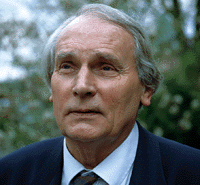Prof. Dr. med. Horst Koeditz — The Ear as a Medical Instrument
Page
1
2
3
4
5
Unlike almost any other organ, our ear is directly connected
with a vast number of our organism’s functions. This connection
runs via the 10th cerebral nerve – the vagus nerve – which, as the “vagabond”,
is connected to all important organs and vascular
systems and, as opponent of the “sympathicus”– the sympathetic nerve – keeps its functions under control.
Looked at from this point of view, our ears have at their disposal, direct
transmission lines to the most important organs of our
body.
“Let it be known,
your illnesses and
your health,
your sadness and
your joys –
all of them come
from your brain.”
Hippokrates
At the same time, our inner ear – stored in a bony labyrinth – is
also where our organ of balance is located and has every
one of our body’s muscles under control.
Prof. Tomatis talks of a “cybernetic regulating circuit:
brain (command) – muscle (execution) – ear (control) – brain
(correction of the command).” So in this way, our inner
ear – unlike almost any other organ – is cross-linked with our entire
organism. But our ear also has yet another special status:
none of our other organs can recognize such fine impulses
and, at the same time, calculate these with such exact mathematical
precision. At all times during this process the ear takes
the calculation of an occurrence of vibration
and classifies it in harmonic and disharmonic orders.
And this brings us to the second part of my talk: to the natural
laws of harmony.
“Our organism strives
to maintain
the natural
rhythmic harmony”
Everyone is born with the ability to distinguish natural
harmonic sounds from unnatural disharmonic ones – this
is just as true for the small child as it is for the old person. This
ability to distinguish sounds is the result of the ear’s
exact calculation of vibration intervals
in relation to one another.
Particular gaps or intervals between two vibrations
are recognized by the ear as “harmonic
”, other intervals
as disharmonic. This order of the harmonic intervals
is called harmonical, and the laws which determine this
order are known as natural laws of harmony, just as Herr Huebner
explained to us earlier. This harmonical conformity
to a law is not, however, characteristic only of our
ear, but is also anchored in our psyche.
You might now ask what all that has got to do with health. Well, a great deal,
as you will soon see.
These harmonical laws, you see, do not only determine what
happens in the interior of the sound and in our ear and our
mental tone experience, we also find these laws of harmony
in many of our organism’s fundamental functions.
And this is surely no coincidence.
Recent studies have shown that the natural function of
our human organism is determined in many different
ways by these natural laws of harmony, which also govern the
microcosm of music. Here, not only the spatial structure
of our organism is variously divided up, its biological-rhythmic
time structure is also ordered according to these natural
laws of harmony – which
Prof. Dr. G. Hildebrandt from the University
of Marburg has, following extensive
research,
been able to show.

Prof. Dr. med. G. Hildebrandt
is one of the fathers of chrono-medicine
and is recognized world-wide as a leading medical authority
in the field of:
chronobiology
balneology
medical climatotherapy
physical medicine
He founded the European Society for Chronobiology
and, for many years, was vice president of the International
Society for Chronobiology.
He also founded the L.R. Grote Institute for Physiotherapy
and Rehabilitation in Bad Berleburg and the Institute
for Research into Remedial Medicine in Bad Wildungen.
At the University of Marburg – until becoming
emeritus professor – he was director of the Institute
for Occupational Physiology and Rehabilitation
Research.
Chronomedicine shows that a natural rhythmic harmony
forms the basis of those processes responsible for the
healthy and economic functioning of the organism – whereas
long-term abandonment of this harmony leads to misinformation
in the nervous system and to malfunctions in the metabolic
activity, and points the way to illness. Today therefore,
in many branches of medicine, rhythmic disorders are
recognized as important indicators of an
oncoming or existing illness.
Our organism strives to maintain the natural rhythmic
harmony and as soon as it loses it, the organism begins
to recreate it during resting phases or sleep. Professor
Hildebrandt was able to determine how, each night, the organism
variously re-establishes its harmonic order again.
This regeneration of the natural harmony in our organism
enables us to embark refreshed on the activities of
each new day, and it shows us that our regeneration means precisely
the recovery of our organism’s natural harmonic
mode of functioning.
If we consider all this, we cannot not be surprised that, nowadays,
Professor Hildebrandt describes the human organism
as nothing short of a ‘music physiology’, because
the way in which it functions orientates itself on the
same natural laws of harmony as the microcosm of music
does.

